- About MAA
- Membership
- MAA Publications
- Periodicals
- Blogs
- MAA Book Series
- MAA Press (an imprint of the AMS)
- MAA Notes
- MAA Reviews
- Mathematical Communication
- Information for Libraries
- Author Resources
- Advertise with MAA
- Meetings
- Competitions
- Programs
- Communities
- MAA Sections
- SIGMAA
- MAA Connect
- Students
- MAA Awards
- Awards Booklets
- Writing Awards
- Teaching Awards
- Service Awards
- Research Awards
- Lecture Awards
- Putnam Competition Individual and Team Winners
- D. E. Shaw Group AMC 8 Awards & Certificates
- Maryam Mirzakhani AMC 10 A Awards & Certificates
- Two Sigma AMC 10 B Awards & Certificates
- Jane Street AMC 12 A Awards & Certificates
- Akamai AMC 12 B Awards & Certificates
- High School Teachers
- News
You are here
Mathematical Treasure: Van Ceulen’s De Circulo
The image below is the title page of De circulo et adscriptis liber, by the mathematician and fencing master Ludolph Van Ceulen (1540–1610). Originally published in Dutch in 1596 as Vanden Circkel, De Circulo is a modified version that Van Ceulen's student Willebrord Snell (1580–1626) translated into Latin in 1619 to make it more accessible.

The engraving on the title page is the same one used for the Dutch original. Notice that below the portrait of Van Ceulen is a circle with diameter of \(10^{20}\). Along the top and bottom semicircles is printed “314159265358979323846 te cort” (too short) and “314159265358979323847 te lanck” (too long). These bounds for \(\pi\) were the best ones available when Vanden Circkel was published in 1596. Later, Van Ceulen determined \(\pi\) to 35 decimal places. As evidence of the importance of Van Ceulen’s work, \(\pi\) has been known as “Ludolph’s number” or the “Ludolphine number”, especially in Germany and the Netherlands. For example, when Ferdinand von Lindemann published his proof of the transcendence of \(\pi\) in 1882, although he used the Greek letter \(\pi\), he also used the term “Ludolph’sche Zahl”. (See “Ueber die Zahl \(\pi\)” 1882, in the middle of page 223.) Even Euler, in a 1743 paper, writes, “It is clear that I employ here the letter \(\pi\) to denote the number of Ludolf van Ceulen 3.14159265 ··· .” (See Lagarias 2013, on page 544.)
Van Ceulen’s work with \(\pi\) was greatly aided when an acquaintance translated from Greek Archimedes’ method using inscribed and circumscribed regular polygons. Below is an image of page 2 of De Circulo showing a regular hexagon inscribed in a circle being used to then inscribe a regular dodecagon.
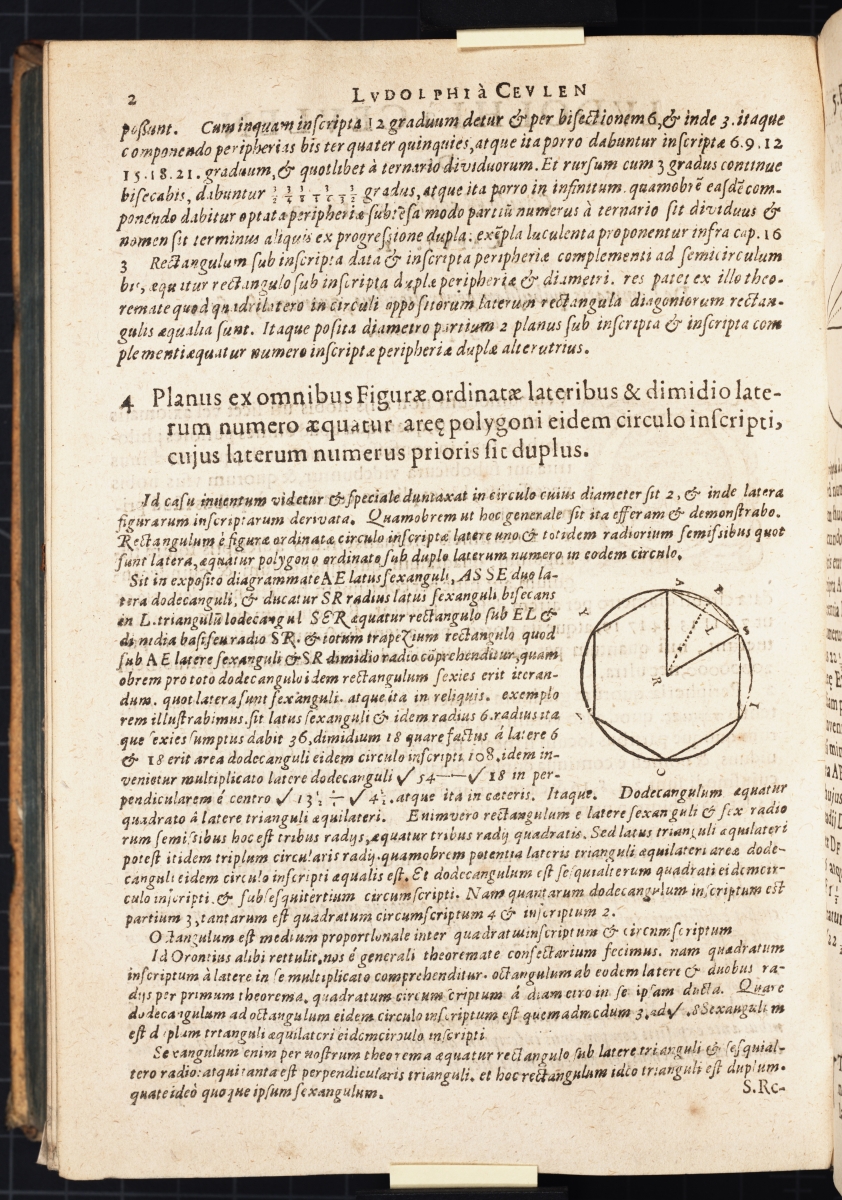
Images from pages 3, 12, and 17 follow. On page 3 is a result relating a rectangle to a square which are inscribed in circles with different diameters. Page 12 starts a chapter dealing with irrational numbers. The notation \(\sqrt{.2}-\sqrt{3}\) is used for \(\sqrt{2-\sqrt{3}}\). Chapter 7 begins on page 17 with an equilateral triangle and a regular hexagon inscribed in a circle.
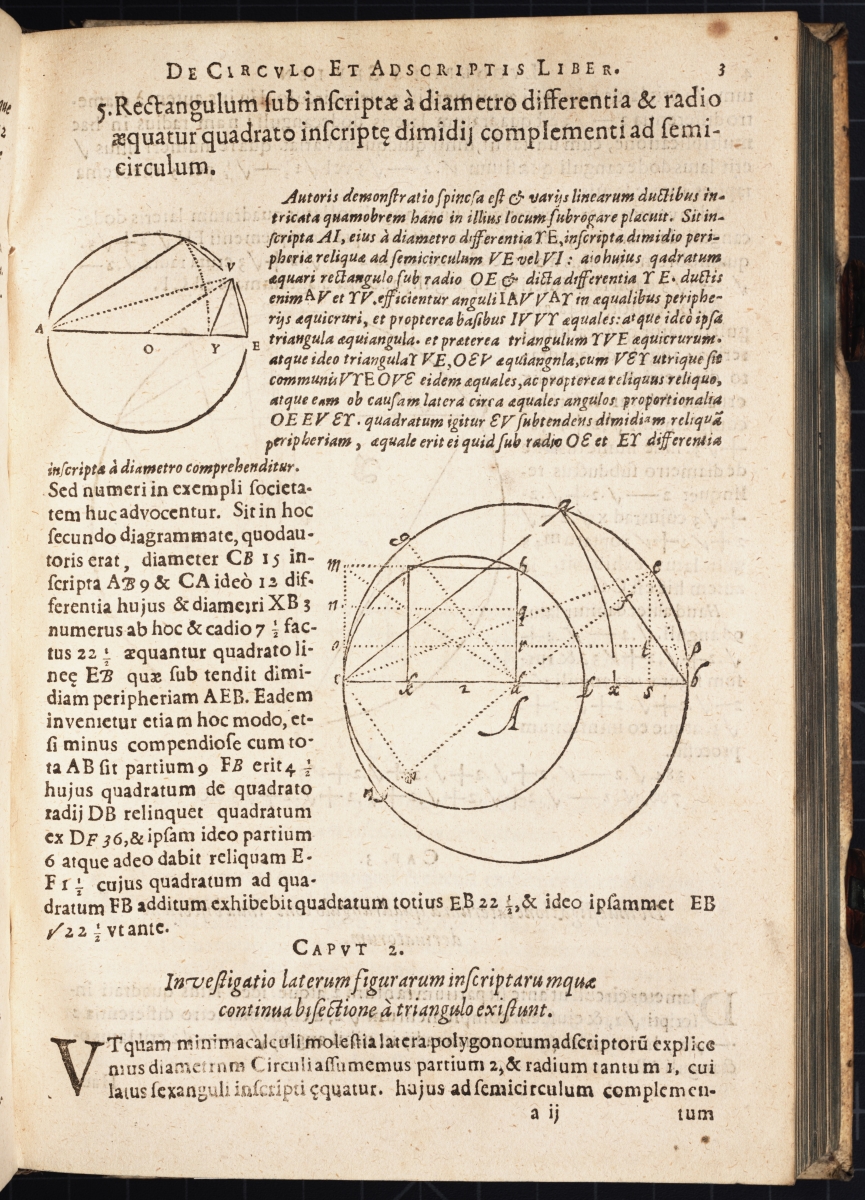

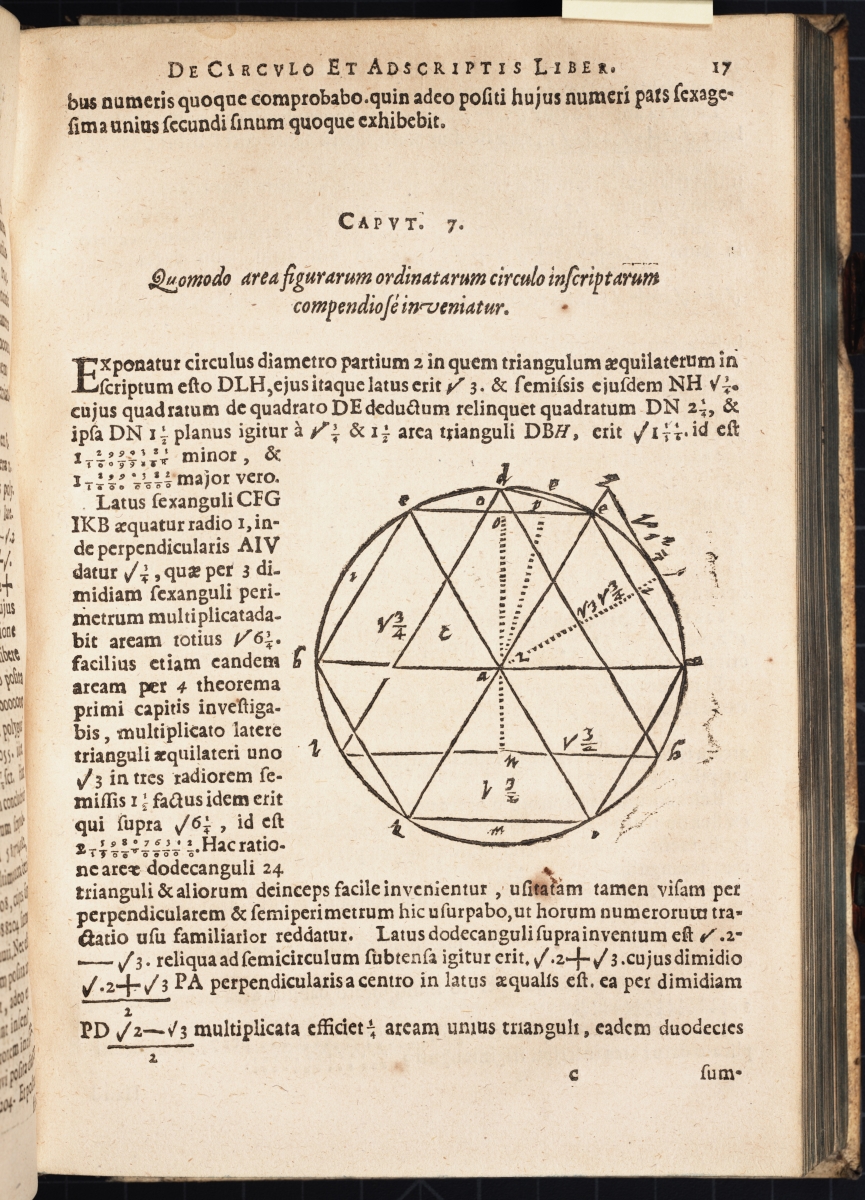
Below on page 5, starting with a square inscribed in a circle with diameter 2, is a sequence of line segments constructed with increasing lengths \(\sqrt{2+\sqrt{2}}\), \(\sqrt{2+\sqrt{2+\sqrt{2}}}\), …
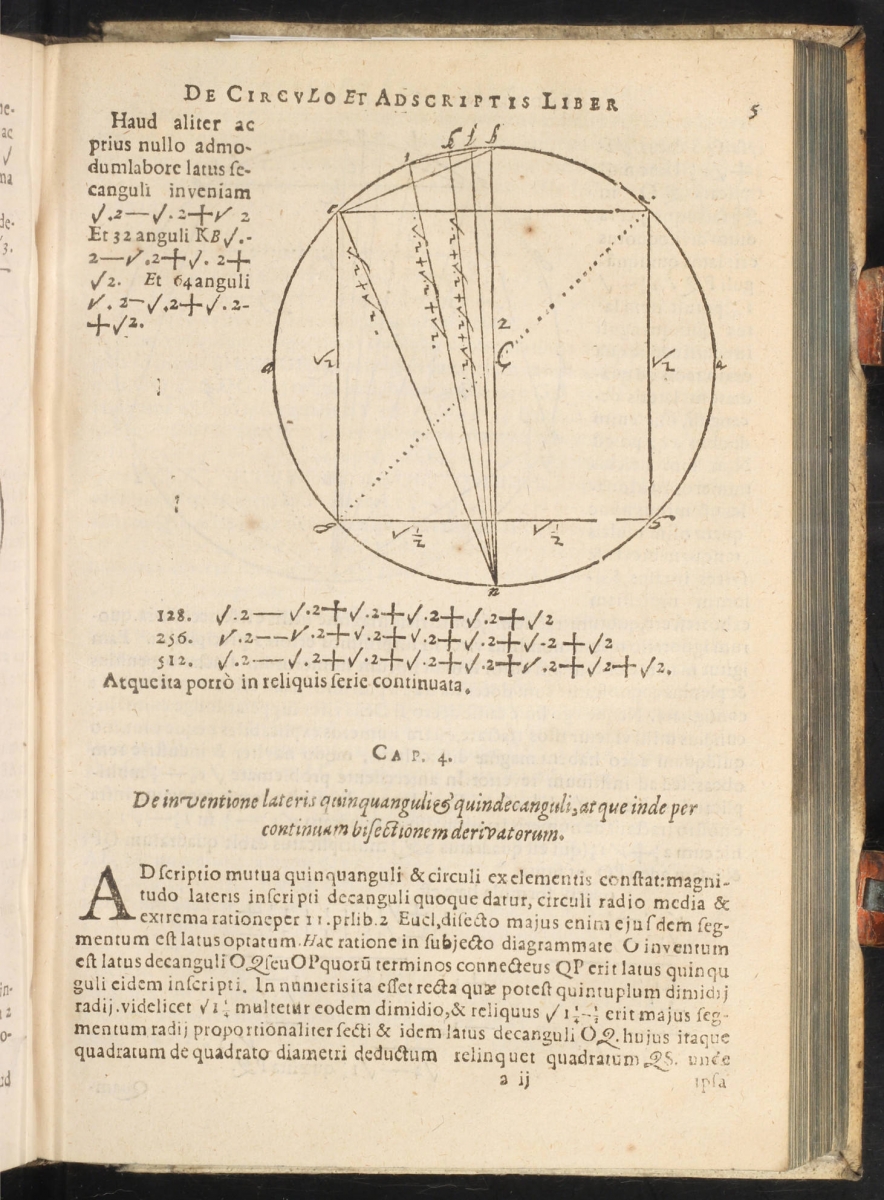
On page 48 below, a table with the length of a side of a regular polygon is inscribed in a circle with radius 200,000,000,000, where the number of sides ranges from 3 to 80. There is at least one typographical error; the first digit for a polygon with 4 sides should be 1, not 2. Below the table is a note giving glory to God for leading Van Ceulen through the work.

On the next page we see N used for a side, Q and a script Q used for square, C for cube, QQ for quartic, QC for quintic, etc.
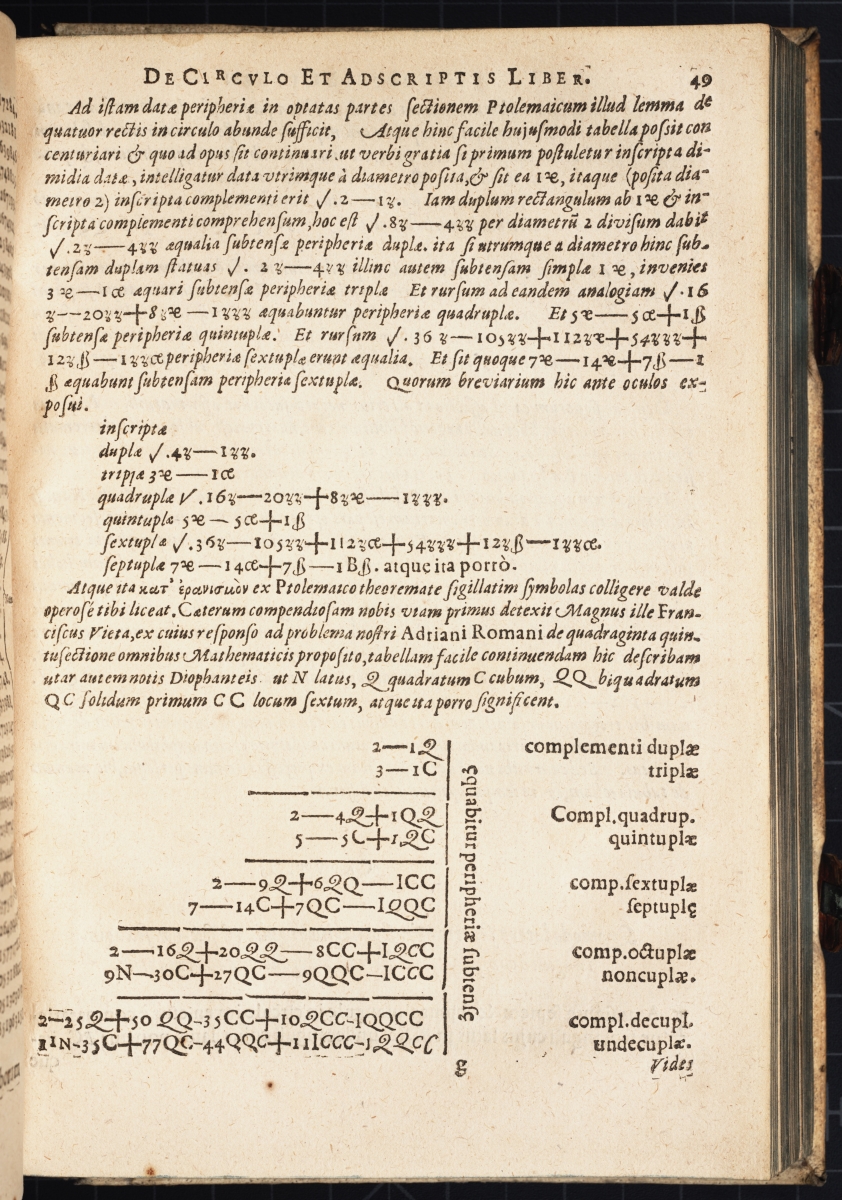
More images from De Circulo are available on Convergence. Images from the 1594 Dutch original Vanden Circkel are also available here.
A complete digital scan of De Circulo is available in the Linda Hall Library Digital Collections. The call number is QA33 .C481 1619.
Images in this article are courtesy of the Linda Hall Library of Science, Engineering & Technology and used with permission. The Linda Hall Library makes available all existing digital images from its collection that are in the public domain to be used for any purpose under the terms of a Creative Commons License CC by 4.0. The Library’s preferred credit line for all use is: “Courtesy of The Linda Hall Library of Science, Engineering & Technology.”
Acknowledgements
Thanks are due to Dominic Klyve, Jeffrey Lagarias, Chuck Lindsey, and Heiko Todt for providing examples of places where the term “Ludolph’s number” appears.
References
Lagarias, J. C. “Euler's constant: Euler's work and modern developments,” Bull. Amer. Math. Soc. 50, no. 4 (2013): 527–628.
“Ueber die Zahl \(\pi\),” Mathematische Annalen 20 (1882): 213–225.
Cynthia J. Huffman (Pittsburg State University), "Mathematical Treasure: Van Ceulen’s De Circulo," Convergence (June 2020)




